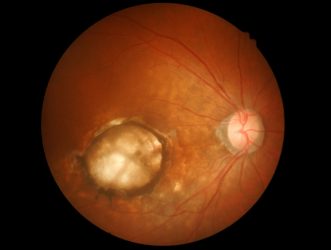Synthesising very long-chain fatty acids to treat retinal conditions
Posted: 31 March 2021 | Victoria Rees (Drug Target Review) | No comments yet
A class of lipids – or fatty acids – found in the retina of the eye play an important role in maintaining vision. Victoria Rees, Deputy Editor of Drug Target Review, spoke with Dr Paul Bernstein from the Moran Eye Center at the University of Utah, US, to discover how very long-chain polyunsaturated fatty acids (VLC-PUFAs) could be used as a strategy to protect patients and prevent the progression of eye diseases including age-related macular degeneration, diabetic retinopathy and some inherited retinal diseases.
PUFAs are consumed in regular diets and are vital for maintaining the health of membranes throughout the body, as well as signalling for inflammation and other responses. The longest fatty acids usually consumed are between 22 to 24 carbon atoms long.
Comparatively, VLC-PUFAs are 30 to 38 carbons long. “The unique thing about VLC-PUFAs is that, as their name states, they are longer than what we usually consume,” said Bernstein, who was part of a study investigating how VLC-PUFAs can be synthesised and administered to improve vision.1 He explained that as these fatty acids are not typically consumed, they have to be made in tissues from the long-chain fatty acids that are shorter and already present.
Why study VLC-PUFAs?
As a retina specialist, Bernstein’s attention has been on VLC-PUFAs in the retina, which are made by enzymes called elongation of very long-chain fatty acids (ELOVLs). The specific focus of Bernstein’s research is the enzyme called ELOVL4.


Having worked in the field for many years, Bernstein and his colleagues have found that
VLC-PUFAs are vitally important for eye health, with defects in VLC-PUFAs causing age-related macular degeneration, among other conditions.
Challenges in studying VLC-PUFAs
“The challenge in studying these defects in VLC‑PUFAs is that animal models are difficult to work with. If you knock out the gene completely, the enzyme which is also important in maintaining the skin barrier that prevents drying out is absent. So, mice with this total defect dry out and die at birth,” said Bernstein.
Another problem involved in studying VLC‑PUFAs is the difficulty of making them in sufficient quantities to analyse; in fact, they are currently not commercially available in large enough quantities for animal or human research. According to Bernstein, they cannot be isolated in sufficient quantities from any natural sources. To address this problem, Bernstein enlisted the help of organic chemists at the University of Utah to develop a novel chemical synthesis process that allowed them to make one VLC-PUFA on a gram scale as opposed to the milligram scale. This enabled them to produce enough of the VLC-PUFAs for use in animal studies, as outlined in their study published in Proceedings of the National Academy of Sciences of the United States of America (PNAS).
The synthesis process
The synthesis process the researchers designed starts with a common natural source”
Bernstein explained that the synthesis process the researchers designed starts with a common natural source. They began with docosahexaenoic acid (DHA) from which the chemists developed a six- to eight-step strategy to add 10 carbon atoms to one end of the molecule, creating C32:6 n-3, the omega-3 VLC-PUFA that the team tested. This enabled the researchers to produce sufficient quantities of high-purity molecules.
Bernstein said that this process of adding 10 carbons can be easily modified to make different lengths of these molecules. He also explained that different starting materials could be used, such as arachidonic acid, to make VLC-PUFAs in the omega-6 series. “We also think that this process could be scaled up to produce much larger quantities that could be used for human studies,” said Bernstein.
Results in animal studies
Having found a method to produce VLC-PUFAs synthetically, Bernstein’s team then administered them orally to mouse models.
“They were taken up rapidly into the bloodstream and delivered to the retina within six to eight hours. We then found, with chronic feeding, that we could see improvements in visual function in these mice and a reversal of some of the negative effects of knocking out the ELOVL4 enzyme locally in the retina,” said Bernstein.
According to Bernstein, the most promising findings were not only that the compound was bioavailable, but that it appeared to be specifically targeted to the retina. The team also observed that the molecule did not seem to be particularly targeted to the liver, which would soak up a lot of the material.
“The most important findings were that we could see it was incorporated into the retina and retinal pigment epithelium, as we might expect for the delivery,” said Bernstein.
There may be a use for VLC-PUFAs in tissues outside the eye”
The team established that visual function improved in the mice from two tests. One technique they used was optokinetic response (OKR), which enabled them to measure visual acuity in the mice. For this, the researchers put each mouse in a box on a pedestal and projected moving stripes around the wall of the box. If the mice saw the stripes, they moved their eyes and heads.
By changing the intensity, contrast and size of the stripes, Bernstein explained that the team investigated whether either the mutant mice or the normal mice administered with the synthetic VLC‑PUFA could see better than they did before, as well as in comparison to the control mice.
The second method the researchers used was an electroretinography test that measured electrical function in response to flashes of light. Bernstein said that they observed improvements in both groups of mice given the VLC-PUFA.
Further development
“The next stage is to optimise our interventions and delivery of the technique,” said Bernstein. The researchers currently have to feed the mice by gavage, which means they use a syringe to administer a little bit of the VLC-PUFA into their mouth and have them swallow. Bernstein said that formulating the orally administered VLC-PUFAs so that they can be incorporated into food is a priority and the dosage and timing must also be optimised.
“We also want to test other compounds, longer chains and other similar compounds in the omega-6 series, to compare to the first VLC‑PUFA that they synthesised. Then, ultimately – following toxicity studies to prove the molecule is safe – we would like to go to Phase I human trials and see that the compound is absorbed, delivered to the right tissues and has a measured function in both health and disease,” said Bernstein.
Looking forwards, Bernstein believes there may be a use for VLC-PUFAs in tissues outside the eye; for example, the testes also have high levels of VLC-PUFAs. He also suggested that since saturated analogues of VLC-PUFAs are involved in skin and brain health, synthetic versions could be used therapeutically in these areas as well.
“We are excited about the proof-of-principle that we can make these VLC-PUFAs in sufficient quantities to start doing animal and other functional studies, eventually moving towards clinical trials,” Bernstein concluded.


Reference
- Gorusupudi A, Rallabandi R, Li B, Arunkumar R, Blount J, Rognon G, et al. Retinal bioavailability and functional effects of a synthetic very-long-chain polyunsaturated fatty acid in mice. Proceedings of the National Academy of Sciences. 2021;118(6):e2017739118.
Related topics
Biopharmaceuticals, Drug Development, In Vivo, Lipidomics, Lipids, Molecular Targets
Related conditions
age-related macular degeneration, diabetic retinopathy
Related organisations
Merck KGaA
Related people
Dr Paul Bernstein








